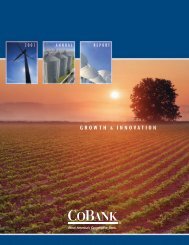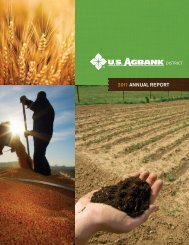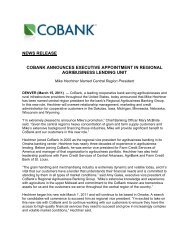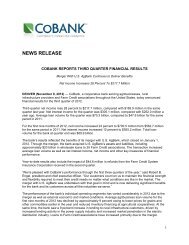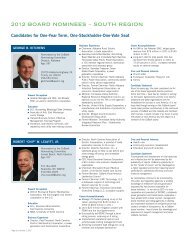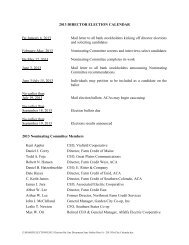Annual Report - CoBank
Annual Report - CoBank
Annual Report - CoBank
- No tags were found...
Create successful ePaper yourself
Turn your PDF publications into a flip-book with our unique Google optimized e-Paper software.
Net interest income increased to $946.0 million in 2009,compared to $862.6 million in 2008. As depicted in the tableon page 30, the 10 percent increase in net interest income wasattributable to greater margins, somewhat offset by decreasesrelated to volume. Net interest margin increased to 1.66percent from 1.51 percent and interest rate spread improvedto 1.64 percent from 1.35 percent in 2008. The differencebetween interest rate spread and net interest margin is thebenefit of noninterest-bearing financing (principally equity).This benefit was lower in 2009 due to a decline in the earningson our equity resulting from lower market interest rates. Inaddition, during 2009 we held an average of $2.3 billion incash, which is not an interest-earning asset, to enhance ourliquidity reserve.Margin and spread increased in 2009 primarily as a resultof the benefit of a steepened yield curve on our asset/liabilityposition. The change in the yield curve resulted from centralbanks throughout the world reducing short-term interest ratesto counter the effects of the global recession. Ourasset/liability position is further discussed in “Interest RateRisk Management” beginning on page 42. To a lesser extent,our net interest income grew due to increased lending spreadswhich reflect increased credit risk in the loan portfolio andoverall market conditions. In addition, a change in the fairvalue of derivatives, as more fully discussed in “Liquidity andCapital Resources – Derivatives” on page 51, also contributedto the increase in net interest income.The benefit of the improvement in margin and spreadwas reduced by a shift in the mix of average earning assets,which totaled $56.9 billion for 2009 compared to $57.1 billionin 2008. This shift includes a significant decrease in loans toagribusiness customers, largely offset by higher levels of loansto Associations, U.S. government-guaranteed internationalloans, loans to energy customers and investments. Loans toAssociations, guaranteed international loans and loans toenergy customers carry lower margins, commensurate withtheir lower overall risk profile and, in most instances, lowerregulatory capital requirements. Our investment portfolio,which is primarily held for liquidity purposes, also carrieslower margins, a lower risk profile and lower capitalrequirements.Average loans decreased to $44.5 billion in 2009compared to $45.4 billion in 2008. Average agribusinessvolume decreased significantly as a result of the sharp declinein commodity prices, including grain and oilseed prices, and inthe cost of agricultural inputs such as fuel and fertilizer. Suchprices reached exceptionally high levels during the first eightmonths of 2008, but have decreased since that time due to anumber of factors, including reduced demand resulting fromthe global recession. The global credit crisis helped drivegrowth in international lending, as the tightening of globalcredit markets led customers to increase their utilization of theexport loan guarantee General Sales Manager (GSM) program,where a significant portion of borrowings are guaranteed bythe U.S. government. The availability of GSM programfunding also increased. Average loans to Associationcustomers increased as a result of growth at our two largestaffiliated Associations and increased participations in thedirect loans of other System banks to certain of their affiliatedAssociations. Growth in our energy portfolio primarilyresulted from increased financing requirements from ourgeneration and transmission and electric distributioncustomers driven by lower levels of available credit in thebroader debt capital markets as well as ongoing new customermarketing efforts.Average investments increased to $12.4 billion in 2009from $11.1 billion in 2008. Average investments do notinclude average cash balances of $2.3 billion and $362.7million in 2009 and 2008, respectively. We have held higherlevels of cash and have purchased short-dated U.S. Treasurysecurities to enhance our liquidity and ensure that ourcustomers have access to a reliable source of credit in allmarket conditions. Our liquidity position is further discussedin ‘Liquidity Risk Management” beginning on page 47.In 2008, our net interest income grew to $862.6 million, a34 percent increase from net interest income of $645.4 millionin 2007. Greater 2008 net interest income was primarily theresult of a $12.7 billion increase in average earning assets. Our2008 net interest margin and interest rate spread increased to1.51 percent and 1.35 percent, respectively, from 1.45 percentand 1.03 percent, respectively, in 2007. Increased margin andspread were primarily attributable to growth in higher-marginagribusiness loan volume, which resulted from significantlyhigher commodity prices throughout most of 2008.Provision for Loan Losses and Reserve for Credit ExposureThe provision for loan losses reflects our expenseestimates for losses inherent in our loan and finance leaseportfolios, including unfunded commitments. We maintain areserve for credit exposure for probable and estimable lossesbased on the factors discussed in “Critical AccountingEstimates – Reserve for Credit Exposure” on page 55.Our provision for loan losses increased to $80.0 millionin 2009 compared to $55.0 million for 2008. The 2009provision reflects credit stress in certain customer industries,including communications, livestock, ethanol and dairy, as wellas the broader impact of the global recession on ourcustomers. Net loan charge-offs were $65.2 million in 2009and primarily related to a limited number of customers in thecommunications and dairy industries. 2008 net charge-offstotaled $18.8 million. Our nonaccrual loans increased to$307.6 million (0.70 percent of total loans) at December 31,2009 from $217.8 million (0.49 percent of total loans) atDecember 31, 2008. The increase in nonaccrual loansprimarily relates to a limited number of customers in theaforementioned industries and was partially offset by thereturn to accrual status of a large loan to a poultry customer.In 2007, we recorded a $5.0 million reversal in ourallowance for loan losses, largely reflective of strong loanquality in that period. Recoveries, net of charge-offs, were$14.0 million in 2007, while nonaccrual loans at December 31,2007 were at a historically low level of $14.8 million.<strong>CoBank</strong> 2009 <strong>Annual</strong> <strong>Report</strong>31




